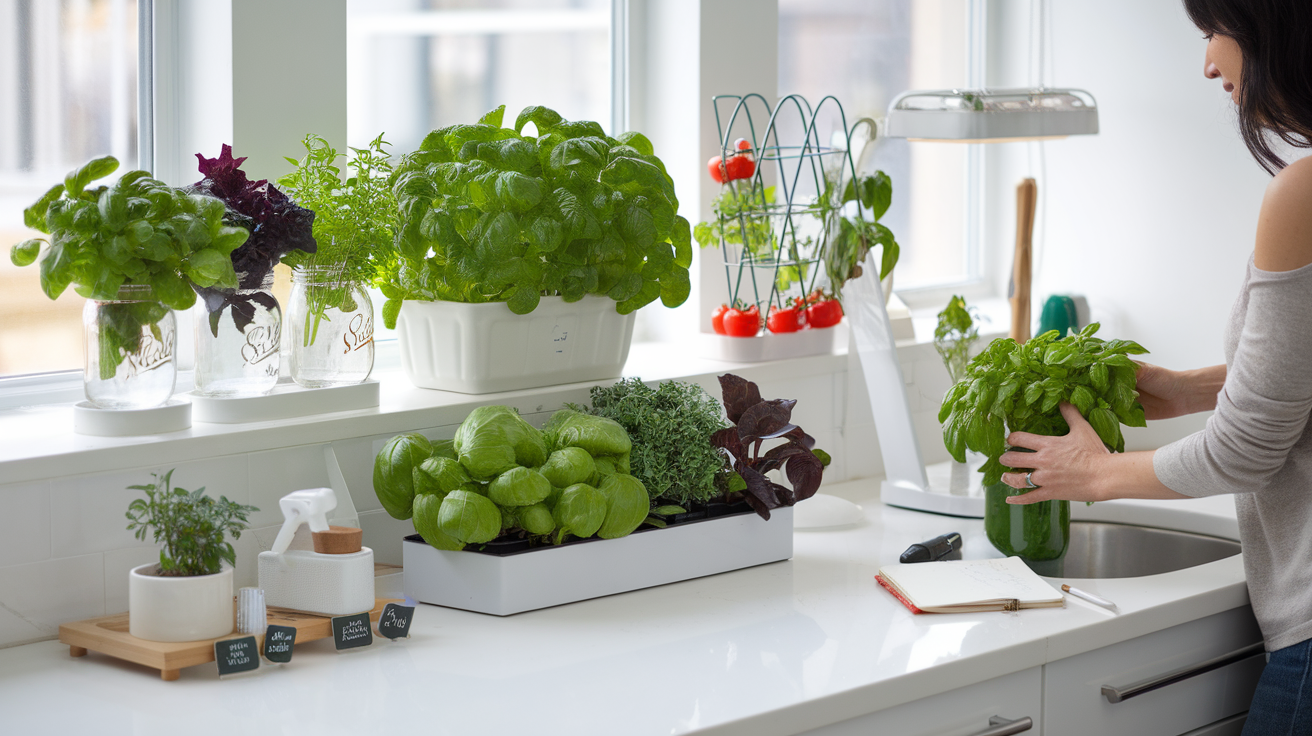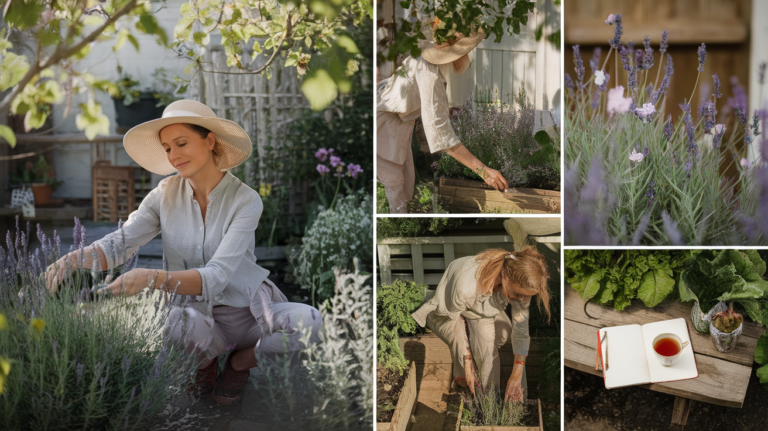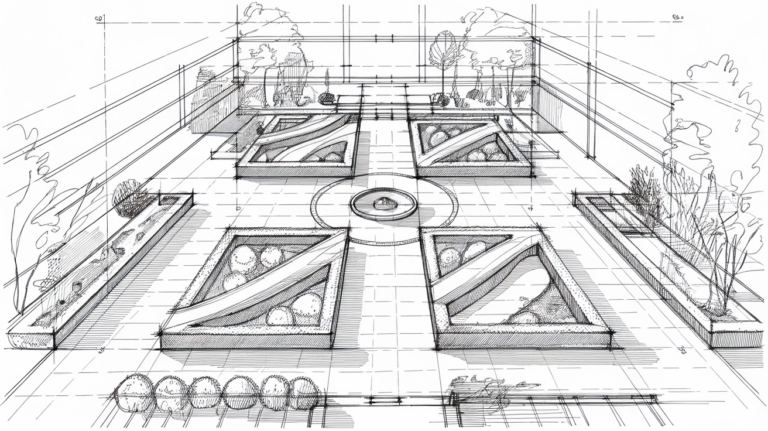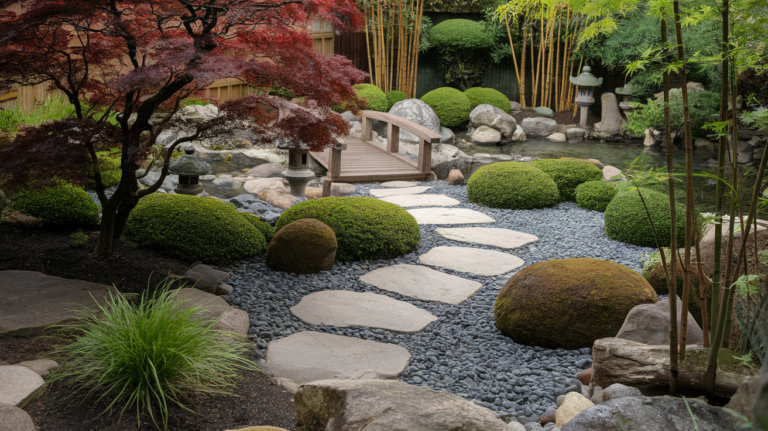25+ Genius Indoor Vegetable Gardening Secrets That Will Give You a Year-Round Harvest (Even in Tiny Spaces!)
Indoor vegetable gardening offers a fun and rewarding way to grow your own fresh produce right at home, no matter the season. With just a little space, some light, and a few supplies, you can enjoy the satisfaction of nurturing your plants and harvesting delicious veggies. It’s a simple way to enhance your meals and bring a touch of nature indoors, all while customizing your little garden to fit your preferences.
Creating an Ideal Indoor Environment

Indoor gardening is a fantastic way to grow your own vegetables, herbs, and plants right at home. The image shows a well-lit indoor garden setup with vibrant green plants thriving under artificial light. This kind of environment is ideal for anyone looking to start their own indoor food garden.
Good lighting is essential for growing veggies indoors. Using a proper light setup, like the one in the image, helps plants get the energy they need to flourish. If you’re thinking about container gardening, this setup is a great example of how to maximize space and produce delicious home-grown food.
Whether you want to grow lettuce or herbs, understanding how to create the right conditions is key. Keep an eye on temperature and humidity, as these factors significantly impact plant growth. With the right indoor vegetable gardening tips, you can easily grow your own vegetables, even in small spaces.
Soil Choices for Indoor Vegetable Gardens

Choosing the right soil for your indoor vegetable garden is key to growing healthy plants. The image shows a variety of soil components that can boost your indoor food garden. Each type contributes differently to your plants’ growth.
At the center of the image are piles of different soil mixes. Dark, rich compost is essential for providing nutrients. A lighter mix can help roots grow without becoming waterlogged. The white granules, likely perlite or vermiculite, improve drainage, helping your veggies thrive.
Container gardening allows you to control your soil mix better. It’s important to tailor your soil for specific plants. If you’re growing herbs or veggies, consider using a mix that retains moisture while allowing excess water to escape.
Look for ready-made blends designed for indoor vegetable gardening. These usually contain the right mix of nutrients and structure for growing vegetables indoors. If you’re feeling adventurous, you can also mix your own using the ingredients seen in the image.
Remember, good soil leads to healthy plants, so spend some time picking the right one. Happy growing!
Essential Tools for Successful Indoor Gardening

Having the right tools is key to thriving indoor gardens. This image showcases a colorful array of gardening tools that every indoor gardener should consider. From watering cans to trowels, each item plays a specific role in helping plants flourish.
The watering cans, in soft hues, are perfect for gently hydrating your indoor vegetables. Whether you’re growing herbs or veggies, a good watering can makes all the difference. Nearby, you can spot various hand tools designed to help with planting and soil preparation. These tools are essential for creating a successful home vegetable garden.
Don’t forget about gardening gloves! The bright yellow gloves in the image not only protect your hands but also add a fun pop of color. They are a must-have when working with soil, ensuring you can dig into container gardening without worry.
Having a clean and organized space for your tools boosts your efficiency. Keeping everything within reach makes it easier to tend your small indoor garden. So, whether you’re growing food indoors or starting a winter lettuce container garden, these tools will become your best friends!
Selecting the Best Vegetables for Indoor Growth

When it comes to growing vegetables indoors, it’s all about choosing the right plants. The image shows a bright and inviting setup perfect for indoor vegetable gardening. You can see several seed packets, including ones for tomatoes and corn, which are great choices for container gardening.
Starting an indoor food garden can be easy and fun. Look at those little seedlings in their pots—they’re just waiting to grow! Common options include lettuce, herbs, and even small peppers. The key is to select vegetables that thrive in smaller spaces.
This setup suggests a great plan for a winter indoor garden. With the right light and care, you can grow veggies indoors all year round. If you’re keen on growing your own vegetables, consider starting with easy plants like lettuce, which adapts well to container gardening.
Remember, indoor growing is all about creating a suitable environment. Make sure to provide ample light and monitor the moisture levels in your containers. With these tips, you can enjoy a vibrant veggie garden right in your home!
Understanding Indoor Plant Lighting Needs

When it comes to growing plants indoors, lighting plays a key role. The image shows vibrant grow lights shining down on a selection of healthy plants. These lights provide the essential spectrum of light that indoor plants need to thrive.
The colors of the lights indicate how they support different types of indoor gardening. For instance, the pink and yellow hues are fantastic for promoting growth in your herb plants and vegetables. If you’re diving into indoor vegetable gardening, understanding these light patterns can really help boost your crop yield.
In your small indoor garden, positioning the lights correctly is just as important as choosing the right plants. Whether you’re growing lettuce or other veggies in containers, the right light ensures they receive enough energy for photosynthesis. Remember to monitor your plants; if they stretch towards the light, it might be a sign they need more exposure.
Container gardening can be super rewarding, especially when you see your indoor food garden flourish. It’s all about finding that balance between light and plant type. So, take cues from the image: invest in good grow lights, and your indoor veggie garden may just become a thriving success!
Choosing the Right Containers for Your Indoor Garden
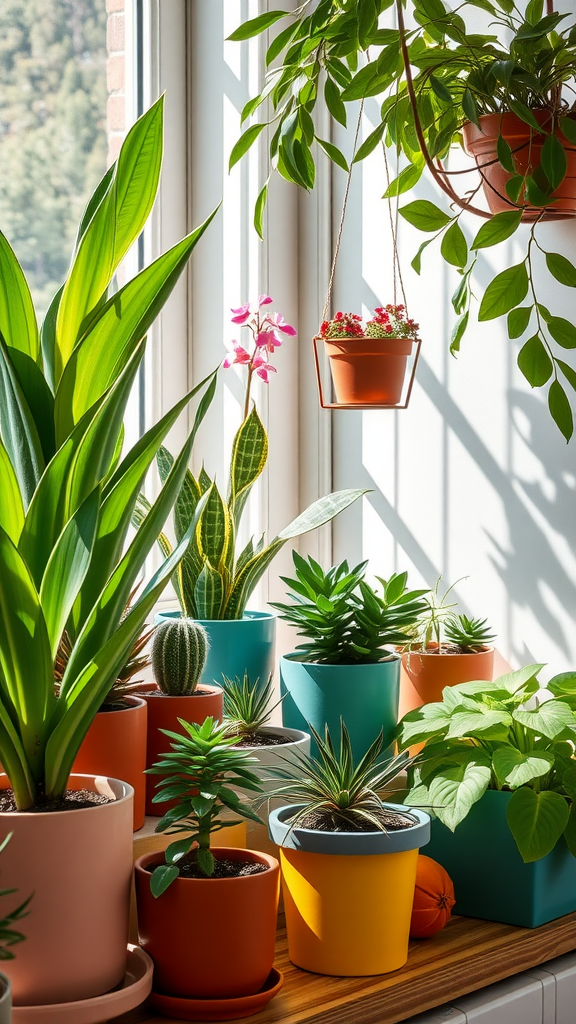
When setting up your indoor garden, the containers you choose play a big role. The image shows a vibrant display of various pots filled with plants, showcasing different colors and sizes. This variety makes it easy to create a lively atmosphere in your space.
For a small indoor garden, selecting pots that complement each other can enhance the look and feel of your area. Notice how the plants are arranged; larger pots hold taller plants, while smaller ones accommodate herbs and succulents. This layering not only looks great but also maximizes sunlight exposure for all the plants.
Container gardening is a fantastic way to grow your own vegetables and herbs indoors. If you’re interested in growing veggies like lettuce or herbs, consider using pots that are at least 6-12 inches deep. This allows for proper root development.
Choosing the right potting mix is just as important as the container itself. A good mix will provide drainage and nutrients, helping your indoor vegetable gardening thrive. Remember, the right container can make your indoor food garden not only productive but also visually appealing!
Watering Techniques for Indoor Vegetables

Watering is a key part of indoor vegetable gardening. The image shows a hand holding a stylish watering can, pouring water on a plant. This simple act can greatly influence how well your veggies grow.
Indoor gardens require different watering techniques than outdoor ones. It’s essential to find a balance. Too much water can drown your plants, while too little can leave them thirsty. Understanding your indoor plants’ needs is vital for success.
When watering, aim for the base of the plant. This method helps deliver moisture directly to the roots. Additionally, using a watering can like the one in the image allows you to control the flow, making it easier to avoid overwatering.
Different vegetables have different needs. For example, lettuce and herbs thrive on consistent moisture. If you’re growing a little indoor garden, pay close attention to each plant’s requirements.
It’s also a good idea to check the soil. Stick your finger about an inch into the soil. If it feels dry, it’s time to water. With the right techniques, you can enjoy home-grown veggies all year round!
Fertilizing Your Indoor Vegetable Garden

Fertilizing is a key step for a thriving indoor vegetable garden. In the image, you can see someone sprinkling fertilizer onto young plants. This is a great way to provide essential nutrients that help your veggies grow strong and healthy.
Whether you’re growing herbs or container veggies, proper fertilization boosts growth and improves flavor. For indoor vegetable gardening, choose a balanced fertilizer that suits your plants’ needs. It’s all about giving your small indoor garden the support it needs to flourish.
Remember, a little goes a long way! Over-fertilizing can harm your plants. Start with a light application and observe how they respond. Indoor vegetables thrive when given the right care, so keep experimenting until you find what works best for your indoor food garden!
Maintaining Humidity for Optimal Growth

In indoor gardening, keeping the right humidity levels makes a big difference. The image shows a humidifier working its magic among various plants. This gadget helps create a cozy environment for your greens.
Humidity is essential for plants, especially when growing veggies indoors. Too little moisture can stress out your plants, affecting their growth. The humidifier in the picture releases a fine mist, ensuring your indoor garden stays healthy and thriving.
If you’re into container gardening or have a small indoor garden, consider using a humidifier. This can boost the growth of your indoor vegetables, herbs, and other plants. For those growing food indoors, maintaining optimal humidity is key to a successful indoor vegetable gardening experience.
Whether you’re using an AeroGarden or growing veggies in pots, having proper humidity supports seed germination and leafy growth. It makes your home vegetable garden flourish and keeps your indoor herb garden vibrant. So, don’t overlook this important factor while planning your indoor gardening setup!
Pest Control Strategies for Indoor Gardens

Indoor gardens can be a growing paradise, but they often attract unwanted guests—pests. The image captures a vibrant array of plants, showcasing how a healthy indoor garden can thrive with proper care. Keeping your plants healthy is key to preventing pest infestations.
Implementing natural pest control strategies is a smart move. You could introduce beneficial insects like ladybugs or use neem oil sprays. Both methods help manage pests without harming your indoor veggies or herbs.
Regular maintenance is also essential. Inspect your plants for signs of pests, like webbing or discolored leaves. A quick check can save you from a bigger problem later.
Consider companion planting, where you grow certain herbs alongside vegetables. This technique can naturally deter pests. For example, planting basil near tomatoes can keep certain bugs at bay, making it a great tip for your home vegetable garden.
Companion Planting for Indoor Vegetables

The image shows a variety of plants thriving in pots, creating a lively indoor garden. These greens aren’t just for decoration; they can be part of your indoor vegetable garden, too!
Companion planting is a helpful technique in gardening. It means growing different plants close together for mutual benefits. For example, some herbs can naturally repel pests while also enhancing the flavor of vegetables. This can be especially useful in small indoor gardens where space is limited.
In an indoor vegetable garden, you can pair herbs like basil or cilantro with your veggies. This not only maximizes space but also boosts the health of the plants. Learning how to grow your own vegetables indoors can be fun and rewarding!
Container gardening is a perfect way to manage your indoor plants. With the right pots, you can create a mini garden that meets your needs. Think about growing lettuce in containers along with herbs. This combination can thrive together and provide fresh ingredients for your meals.
As you set up your small indoor garden, consider what plants work best together. Growing veggies indoors can be a delightful experience, especially when you see them flourish side by side.
Temperature Regulation for Indoor Gardens

Keeping an eye on the temperature is key for your indoor garden. The image shows healthy plants alongside a thermometer. This setup highlights how important it is to monitor the environment for your plants to thrive.
The thermometer indicates the current temperature, helping you maintain the right conditions for your vegetable planting. Indoor gardens need a stable temperature, especially when growing vegetables indoors. Plants like peppers and herbs prefer warmth, while others might need a cooler setting.
When growing veggies indoors, consider where you place your plants. Too much heat can stress the plants, while too cold can stunt their growth. An indoor vegetable garden should ideally stay between 70°F and 75°F for most veggies. Using a thermometer helps you keep track of these numbers.
If the temperature gets too high, think about adding a fan or adjusting light sources. Proper temperature control can lead to healthier plants and better yields in your home vegetable garden.
Harvesting Tips for Indoor Vegetables

Harvesting indoor vegetables can be a rewarding experience, as seen in the image where a hand gently touches the tender green leaves of tomato plants. These plants are flourishing in a cozy indoor setting, showcasing the beauty of indoor gardening.
When you’re growing veggies indoors, it’s important to know when to harvest. Watching for color changes, like those green tomatoes turning a warmer hue, can signal that they are ready. Regularly checking your plants keeps them healthy and encourages growth.
In a small indoor garden, like the one pictured, space is precious. Using containers for growing your vegetables is an excellent way to manage this. Make sure to choose the right size pot for your plants, ensuring they have enough room to grow. Container gardening allows flexibility and creativity in how you arrange your veggies.
Don’t forget to give your plants proper care. Adequate light is essential, so place them near windows or use grow lights. Water them appropriately, letting the soil dry slightly between waterings to prevent overwatering.
Indoor vegetable gardening can be simple and fun. With tips on how to grow your own vegetables, you can enjoy fresh produce right from your home. Happy gardening!
Vertical Gardening Techniques for Small Spaces
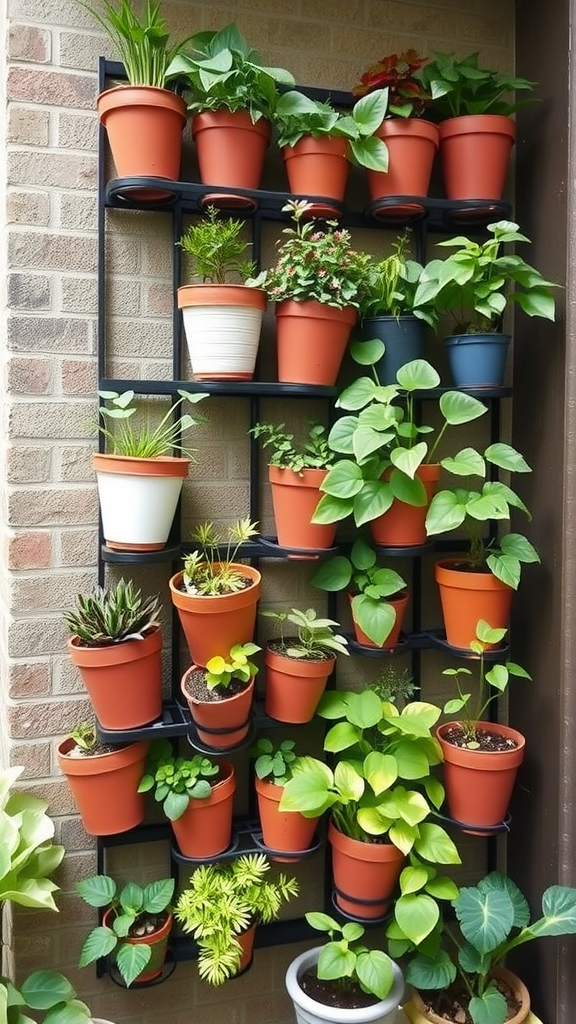
Vertical gardening is a fantastic way to make the most of limited space. The image above showcases a stunning example of a vertical garden, utilizing wall-mounted planters to display a variety of plants. This method not only looks appealing but also maximizes your growing area.
In the image, you can see pots of different shapes and sizes, filled with lush green plants. From herbs to ornamental plants, each pot adds a splash of color and life to a small area. This setup is perfect for anyone interested in growing their own vegetables or herbs indoors.
For those considering a vertical garden, it’s important to choose the right plants. Herbs like basil and mint thrive in vertical setups, making them ideal for a small indoor herb garden. Vegetables such as lettuce can also do well in containers, allowing you to grow your own veggies right at home.
Starting a vertical garden involves selecting an appropriate structure. Wall-mounted shelves or trellises work great for hanging pots. You can also incorporate a simple container gardening approach by using pots of varying heights, which adds depth and visual interest to your space.
Don’t forget to consider drainage and light! Ensure your plants receive enough sunlight for healthy growth. Growing food indoors can be just as rewarding as traditional gardening, providing fresh ingredients right at your fingertips. Whether you’re new to indoor vegetable gardening or looking to expand your green thumb, vertical gardening is a delightful and practical solution.
Dealing with Indoor Plant Diseases

Indoor gardens can be a joy, but they also come with their challenges. The image captures someone examining a plant, which highlights the importance of keeping an eye on your greenery. When you notice any signs of distress on your plants, it’s vital to act quickly.
Common indoor plant diseases include powdery mildew and root rot. These can be caused by overwatering or poor air circulation. If you’re growing vegetables indoors, like lettuce or herbs, check for these issues regularly. Maintaining a good watering schedule and ensuring proper light can help prevent these diseases.
Using healthy soil and clean pots is crucial for your indoor vegetable gardening. If you spot a problem, don’t hesitate to remove affected leaves. This helps stop the spread and keeps your indoor food garden thriving. Always remember, a small indoor garden needs your attention to flourish!
Propagating Your Favorite Vegetables Indoors
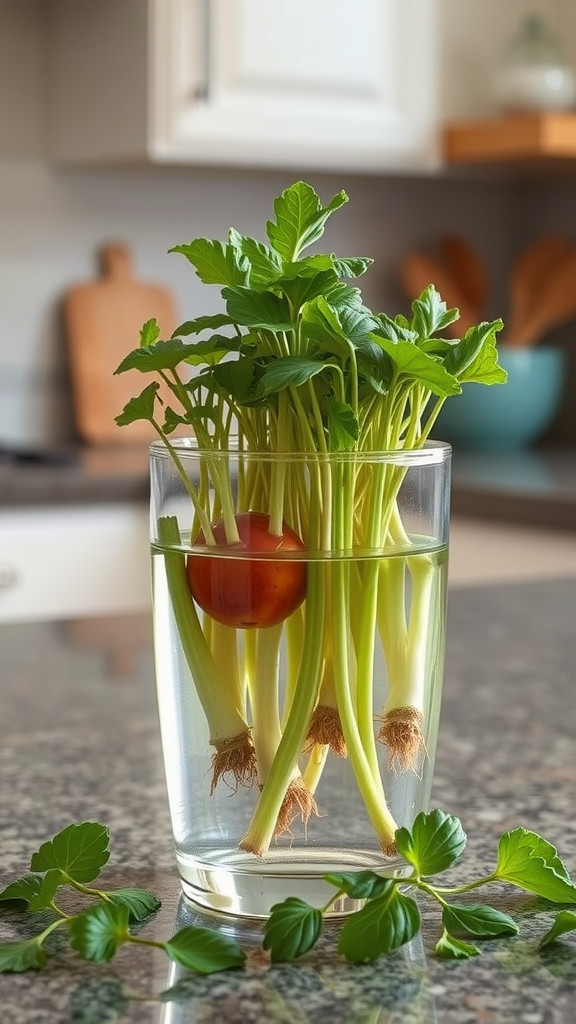
Growing vegetables indoors can be a delightful and rewarding experience. The image shows a simple yet effective way to propagate vegetables like green onions and tomatoes. By placing the roots of these plants in a glass of water, you can encourage new growth right on your kitchen countertop.
This method is great for those interested in how to grow your own vegetables without a garden. It’s an easy start to indoor vegetable gardening, perfect for small indoor gardens. The clear glass not only allows you to monitor the roots but also adds a decorative touch to your space.
For container gardening, this approach works well as it requires minimal resources. You can place your vegetable scraps in water, and soon, you’ll see new green shoots emerging. It’s an ideal way to grow veggies like lettuce or herbs—just imagine having fresh greens at your fingertips!
When you decide to grow your own vegetables indoors, remember that light is essential. Position your glass in a spot that gets plenty of sunlight, or consider using grow lights if your space is dim. With a bit of care, you’ll enjoy the process of growing food indoors, all while adding a touch of greenery to your home.
Seasonal Indoor Gardening Considerations
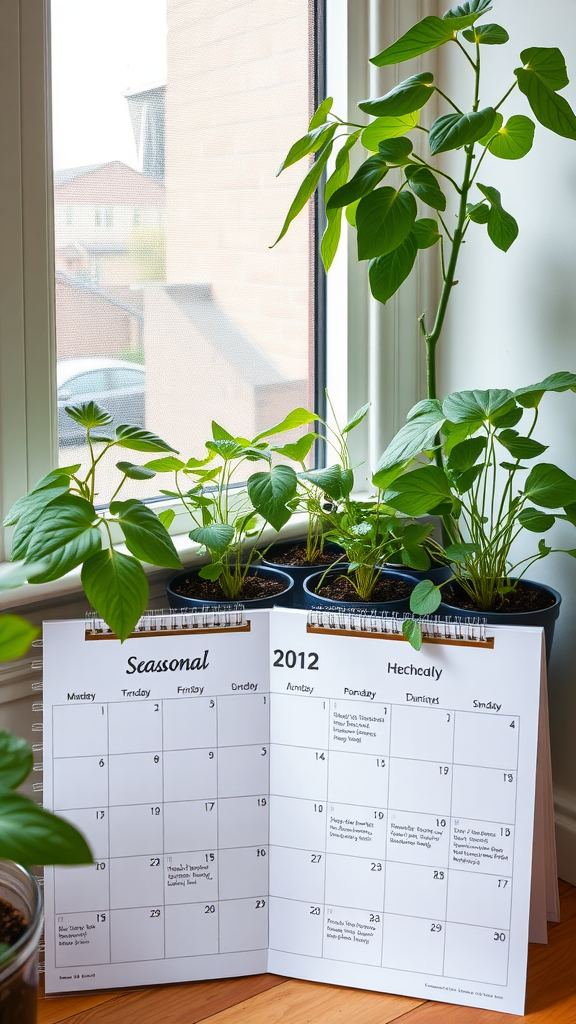
Indoor gardening can be a delightful way to bring freshness into your home, especially during the colder months. The image shows a sunny windowsill with thriving plants next to a calendar titled ‘Seasonal’. It hints at the importance of timing when it comes to growing veggies indoors.
Looking at your calendar is a great way to plan your vegetable planting. Knowing when to start seeds can make a big difference in your indoor food garden. For example, some plants like lettuce are perfect for container gardening and grow well in cooler temperatures.
As you think about your small indoor garden, consider which vegetables you want to grow. Items like herb plants or leafy greens can thrive in pots with good soil and proper light. Not only are they easy to maintain, but they’ll also add vibrant flavors to your meals.
If you’re thinking about growing food indoors, remember that indoor vegetable gardening can be straightforward. Focus on plants that fit your space and lifestyle, and don’t forget to check the calendar for optimal planting times. Whether you’re using a small indoor garden setup or a dedicated herb garden container, planning is key to enjoying the fruits of your labor!
DIY Indoor Garden Systems and Kits

This image shows a beautifully arranged indoor garden setup, perfect for anyone looking to grow their own veggies or herbs at home. You can see various plants in stylish pots, showcasing the potential of small indoor gardens.
With a bright light fixture above, this setup highlights how to grow indoor vegetables effectively. The combination of plants suggests options for a home vegetable garden or a herb garden, making it easy to start container gardening right in your living space.
If you want to grow vegetables indoors, consider starting with easy options like lettuce or herbs. Container lettuce gardening is a great way to begin your indoor food garden. You can also explore how to grow your own vegetables in pots if you have limited space.
Creating a Garden Journal for Indoor Gardening
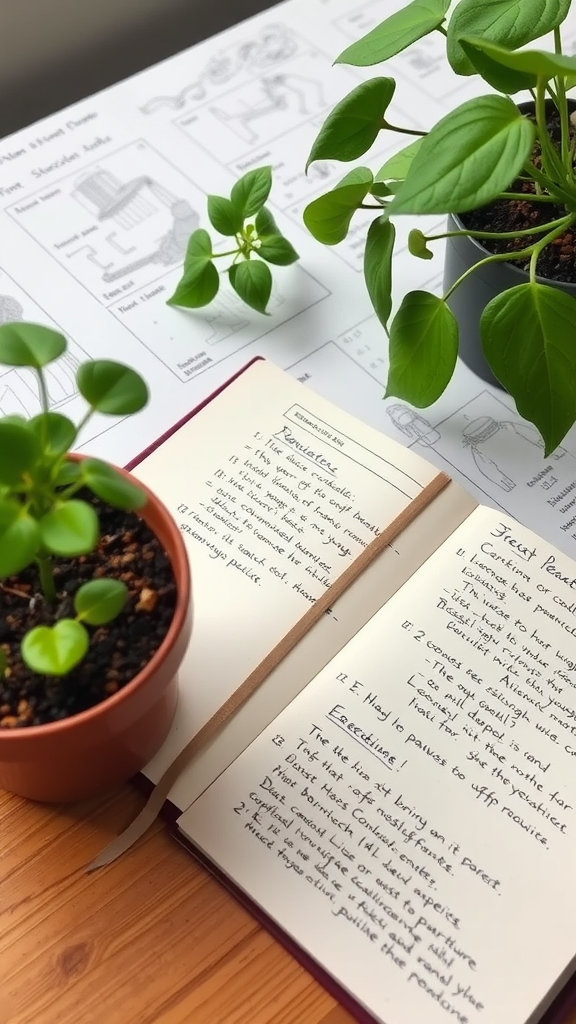
Creating a garden journal can be a game-changer for anyone interested in indoor gardening. The image showcases a cozy scene where a notebook filled with notes sits beside vibrant green plants. This setup highlights the joy of documenting your gardening experience.
The notebook likely contains valuable insights on how to grow vegetables indoors and tips for maintaining a thriving indoor herb garden. Writing down your observations helps you track what works best for your small indoor garden.
Plus, it’s a great way to brainstorm ideas for your container gardening projects. Whether you’re jotting down requirements for vegetable planting or strategies for growing food indoors, your journal can become a vital tool in your gardening journey.
So, grab your notebook and start noting down your thoughts on growing veggies in pots or the best methods for lettuce container gardening. It’s not just about the plants; it’s also about enjoying the process!
Maintaining Air Circulation in Indoor Gardens

Keeping air moving in your indoor garden is key for healthy plant growth. The image shows fans next to thriving plants, which is a great way to show how air circulation supports their wellbeing.
Good air circulation helps prevent mold and pests while promoting strong stems and healthy leaves. This is especially important in a small indoor garden where humidity can build up quickly. Using fans is an effective solution, creating a gentle breeze that mimics natural outdoor conditions.
For indoor vegetable planting, like lettuce or herbs, ensure your setup allows for airflow. You can easily start growing your own vegetables indoors with proper air movement. Fans can be placed strategically to help circulate air around your vegetable plants, keeping them fresh and thriving.
Remember, air circulation is not just about preventing issues; it also boosts growth. So, whether you’re looking into a small indoor garden or container gardening, incorporating a fan is a simple yet effective way to enhance your indoor food garden.
Indoor Vegetable Gardening for Beginners

Indoor vegetable gardening is a great way to enjoy fresh produce right at home. The image shows a cozy setup filled with various plants. You can see pots of vibrant greens and even some small tomatoes ready for harvest. This scene perfectly illustrates how an indoor space can transform into your very own food garden.
Setting up a small indoor garden is simple and rewarding. You can start with easy-to-grow veggies like lettuce and herbs. These plants thrive well in containers, making them perfect for indoor planting. Consider using the right pots and ensuring they have good drainage for healthy growth.
Using grow lights, as seen in the image, can help your plants get enough light, especially during winter months. This is one of the best tips for growing vegetables indoors. You’ll find that with a little effort, you can grow your own vegetables, creating a small indoor herb garden or a full veggie garden.
Whether you’re interested in an indoor food garden or container gardening, the satisfaction of nurturing your own plants is unmatched. Plus, it adds a touch of greenery to your space, making it more inviting. You’ll love the fresh flavors of homegrown vegetables!
The Benefits of Indoor Vegetable Gardening

Indoor vegetable gardening offers many benefits, and this image captures one of the most delightful aspects: family bonding. Here, a family enjoys their time together while tending to their indoor vegetable garden. The smiles on their faces show how rewarding it can be to grow your own food.
With indoor gardening, you can cultivate fresh veggies right in your home. Whether it’s tomatoes, lettuce, or herbs, the options are endless. This family is holding a fresh zucchini, which is just one example of what you can grow in a small indoor garden.
Growing food indoors can be a fun way to teach kids about gardening. They can learn how to plant seeds, care for their plants, and eventually enjoy the fruits of their labor. This engagement fosters a love for healthy eating and sustainability.
Container gardening is a great method for those with limited space. Using pots and containers, you can easily create a productive indoor garden. There are even specific tips for growing lettuce or herbs in containers, making it simple to start your indoor vegetable garden.
In summary, indoor vegetable gardening not only provides fresh produce but also creates wonderful memories with loved ones. It’s a rewarding hobby that can lead to a fulfilling lifestyle.
Caring for Indoor Edible Flowers
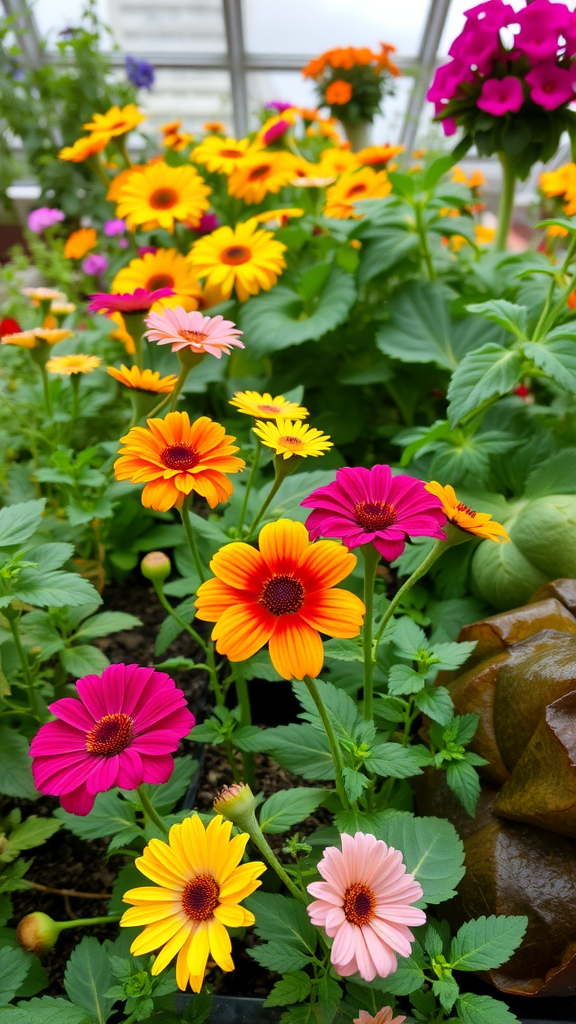
Indoor edible flowers can brighten up your home and add a splash of color to your meals. The vibrant blooms you see here are not just for looks; many of them are edible and can enhance your favorite dishes.
When caring for these flowers, ensure they get plenty of sunlight. A south-facing window is perfect for most varieties. Regular watering is key, but be careful not to overwater. Let the soil dry out slightly between waterings.
Consider growing your own indoor vegetable garden. You can mix flowers like nasturtiums or pansies with herbs in a small container garden. These not only look lovely together but also provide tasty edible options.
Container gardening is a great way to start. Choose pots that drain well and use good-quality potting soil. This will help your plants thrive. You can easily grow vegetables and herbs alongside your flowers for a mini indoor food garden.
As you care for your indoor flowers, remember to check for pests. A gentle wash with water can help keep them clean. Enjoy the process of growing your own veggies and edible flowers!
Using Hydroponics for Indoor Vegetable Growing

This image showcases a modern hydroponic setup in a cozy kitchen, perfect for growing veggies indoors. The clean, sleek design of the growing system makes it a great fit for any home. The bright LED lights above provide the necessary light for the young plants, ensuring they thrive even without natural sunlight.
In this indoor vegetable garden, you can see various plants sprouting from the substrate. Hydroponics allows you to grow a variety of vegetables, herbs, and even fruits in a controlled environment. It’s an efficient way to produce fresh food and can fit into small spaces, making it ideal for urban living.
If you’re interested in container gardening, this setup gives you a fantastic idea of how to start growing plants indoors. With simple steps, you can create your own indoor herb garden or grow vegetables like lettuce in containers. This method not only saves space but also provides a fun and rewarding way to grow your own food at home.
Integrating Indoor Plants into Home Decor

Indoor plants bring a fresh vibe into any living space. This image shows a cozy corner filled with vibrant greenery. The plants vary in size and type, creating a lively scene. A tall leafy plant stands proudly by the window, soaking up the sunlight, while smaller plants add layers and texture around the room.
Integrating plants into your decor can transform your home. They not only look great but also improve air quality. For those interested in vegetable planting indoor gardens, consider starting small with indoor vegetable gardening. Growing your own veggies indoors can be rewarding, and it doesn’t require much space.
Container gardening is a fantastic way to manage indoor plants. You can grow herbs or even small lettuces right in your kitchen! With tips on how to grow your own vegetables, you can easily create your own indoor food garden. Just make sure to choose the right containers and provide enough sunlight.
Don’t forget about herb plants! An indoor herb garden can be both practical and beautiful. You can have fresh herbs at your fingertips while enhancing your home’s decor. Growing food indoors is simple and satisfying, especially with the right guidance.
Incorporating Technology in Indoor Gardening

Indoor gardening has taken a fun turn with the help of technology. The image shows vibrant plants thriving in their pots, alongside two smartphones. These devices are more than just communication tools; they help us monitor and care for our plants.
On one phone, a colorful app displays various metrics related to plant health, making it easy to track conditions. This could be a game-changer for anyone looking to grow their own vegetables indoors. Whether you’re into growing veggies or maintaining an herb garden, such apps can guide you through the process.
The second phone features a variety of gardening apps, from tips on container gardening to reminders for watering schedules. This is especially useful for those starting a small indoor garden. With technology, you can enjoy the satisfaction of home vegetable gardening without the worry of over or under-watering.
Using technology for indoor gardening allows you to grow your own vegetables and herbs with ease. It turns a simple hobby into an organized and enjoyable activity. Who knew that growing food indoors could be so accessible and fun?
Sustainable Practices for Indoor Gardening

Indoor gardening is a wonderful way to bring life into your home while growing your own veggies. The image showcases a variety of plants thriving in a cozy indoor space, perfect for a small indoor garden. You can see pots filled with leafy greens and herbs, which are ideal for container gardening.
Starting your own indoor vegetable garden is simpler than you might think. You can grow vegetables indoors even in limited space. For example, lettuce and herbs are great choices for container gardening. They don’t require much room and can flourish with the right care.
Consider investing in an Aero Garden or similar system for optimal growth. It can help you grow vegetables indoors year-round, providing fresh ingredients for your meals. Remember, good lighting and proper watering are key to success. There’s nothing like the taste of homegrown food!
Exploring Organic Pest Control Methods

The image shows a hand holding a small spray bottle, aimed at vibrant green leaves. These leaves likely belong to plants in a container garden, making it a perfect fit for those growing veggies indoors or herbs. The presence of a small insect on the leaf suggests the need for pest management.
Organic pest control methods are friendly alternatives to synthetic chemicals. Using natural sprays can help keep your indoor vegetable garden healthy. Whether you’re growing lettuce or herbs, keeping pests at bay is essential for a thriving indoor food garden.
For effective pest control, consider using a homemade pesticide. A simple mix of water, soap, and a few drops of vegetable oil can work wonders. This method is safe for your plants and the environment. Just remember to test it on a small area first!
Indoor Vegetable Gardening Conclusion
Vegetable planting in indoor gardens allows you to enjoy fresh produce all year round. Whether you’re keen on lettuce container gardening or starting an indoor herb garden, the options are endless. You can grow your own vegetables in pots and watch them become delicious additions to your meals.
One great tip is to ensure your plants have enough light. Using grow lights can help if natural light is limited. Don’t forget to choose the right containers, too! With some planning, your home vegetable garden can yield a healthy harvest. Remember, growing food indoors not only saves you money but also brings a bit of greenery into your space.
So, gather your gardening supplies and start your container gardening journey. Growing veggies indoors can be a fun and rewarding experience!

